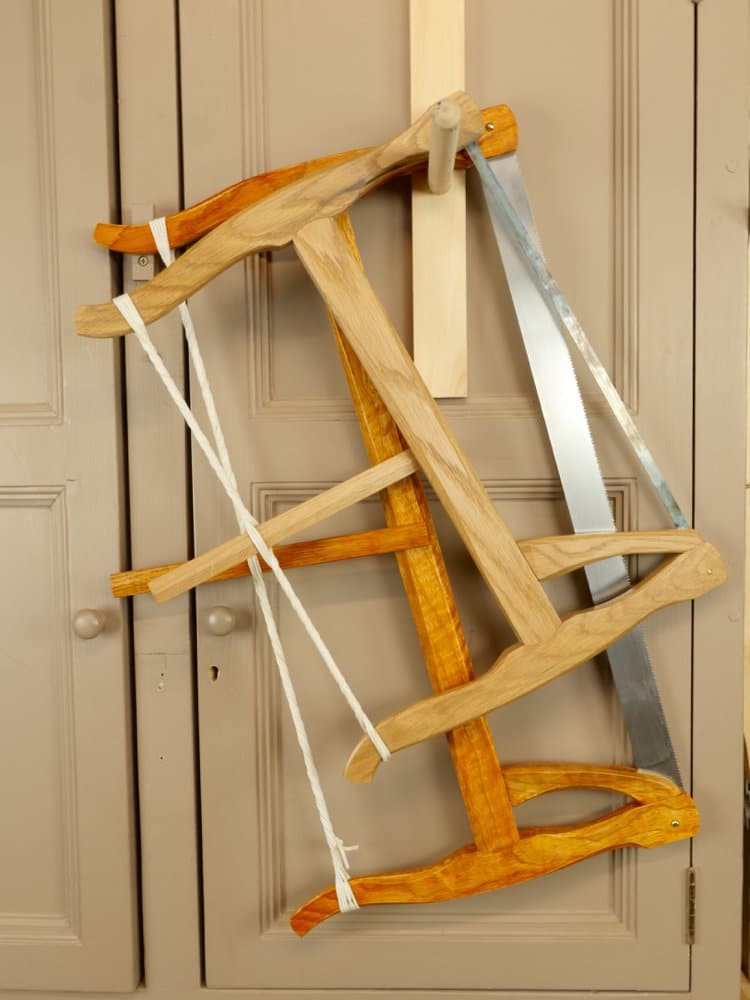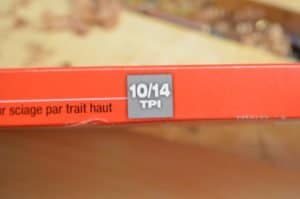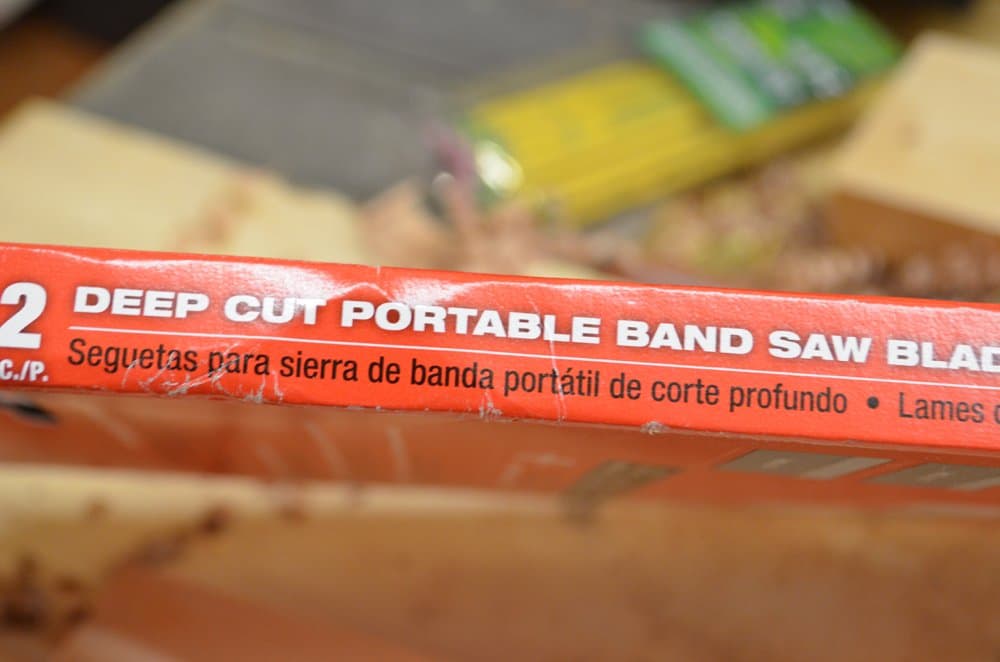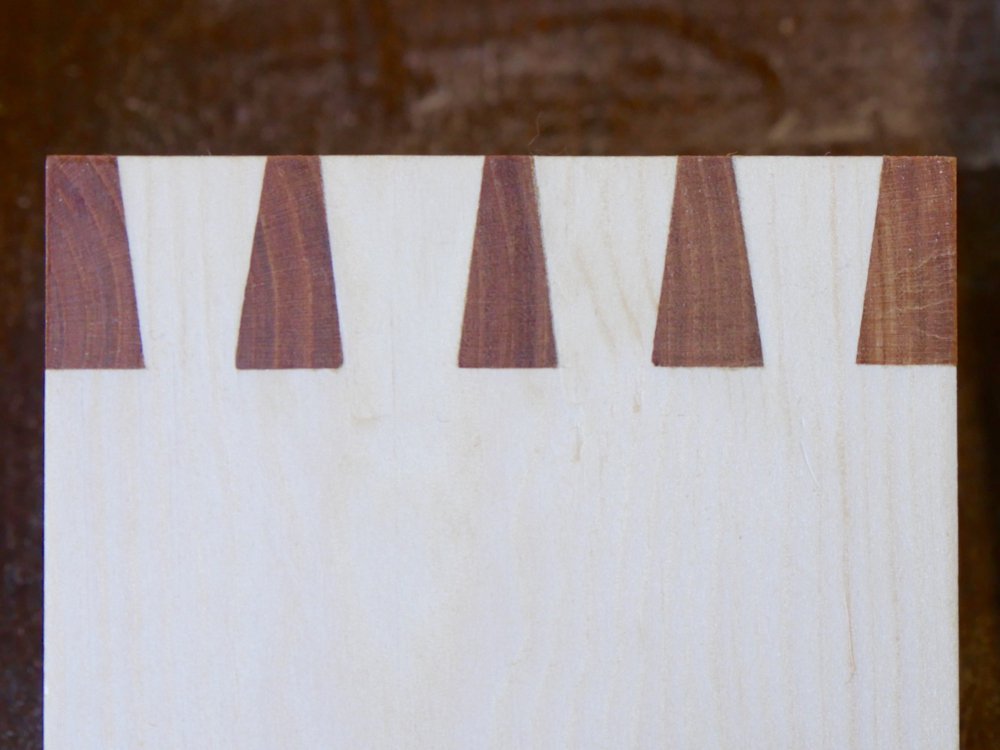Making Frame Saws

The real point in having them is that they give you a low cost joinery saw for a few scraps and a blade. I bought the frame saw blades from Dieter Schmidt at Fine tools in Germany who shops world wide but for EU people their shipping is good. The same blade types are available from Highland Woodworking. These blades do not cut metal. If you want a metal cutting blade which is the one I cut these dovetails with then install a metal cutting bandsaw blade into the same saw. I make my own blades by snapping the blades to length by bending the bandsaw blade back and forth to snap it. then I drill holes for the screw holders.





Hello, Paul. I have watched the Youtube video and just watched Part 3 of the Masterclasses series today (I was glad you had it posted today. I’m making my own and was caught up through Part 2!) I think it will be a very useful saw and I always enjoy building my own tools. I had already purchased a 14 TPI metal cutting blade made by Olsen after watching Part 1. ACE Hardware here in the US carries them, as well as being available on eBay with free postage for about the same cost (approx. $8.00 US). I’ll let you know how this brand performs so you can pass it along. Once again, thanks for all you do and another great project.
Gary Blair
Lander, Wyoming
Great, Gary, thanks for your input.
Paul are the parts all 3/4 ” thick, I didn’t see dimensions listed. Thanks
Yes, 3/4″ thick is fine.
Hi Paul,
I suspect the reason for the low uptake on this series was mentioned in the comments on Episode 1:
“Peter Holt
9 October 2015 at 9:48 pm
Had an email saying that a free video on building a frame saw was available, but it will not let me see it because “Hmm, it looks like you cannot access this content. This is probably* because you are not a paying member. “… So much for free…
Pete”
I had had the same result, and assumed from then on that the frame saw was only for paying members, and disregarded anything further. When I noticed the YouView version, I again assumed that it was just a taster, to bring people into membership.
“Assume” – puts you somewhere between an Ass and me.
It is a free video series on woodworkingmasterclasses. We will check in to see if there is or was a problem. I should say that you do have to subscribe for the free membership.
I would say this to clear up ambiguity too. We made a decision several years ago that everything that was tool making, tool review, tool technique, methods of work and so on would always be free for everyone. We generally avoid tasters and teasers but if we do a promotion it is to simply let people know that we have made a video that they might be interested in.
.
Mea culpa. Sorry. :-/
I’m usually good with words, but this time I was wrong on both counts. BTW Paul, I’ve been a ‘subscriber’ to the free membership for quite a while, but I did get that message about it being for paying members only. There must have been a short period when this was so, and then changed later, because I went to the link in the notifying email very quickly having already been at my pc when the email arrived. Sadly, I didn’t go back to try again later (until today).
Glad you got it now. it could have been a glitch because someone else said the same.
Video is free to subscribers even if you don’t sign up for master classes. Must be a glitch on your end or you may not be registered as a subscriber yet. Paul’s blogs have been very informative, and you should be thankful for them instead of criticizing because you have a problem. When problems occur, at least contact him to see how it can be made right. I’ve not noticed any dishonesty or misdirection in any content from him so far. Hope your future attempts work out better.
I have to say, I thought the videos were the same, until tonight, when I was wondering why they were split up for WoodworkingMasterclasses, but there was only one shorter video for youtube. And then it hit me, that they were different. And I went straightaway and watched the three-part video series, too. I’m guessing most people watched one or the other, not realizing they were different. Both were lovely, so thank you for posting.
Hi momist, it says it blasted off with the lowest inertia ever. That indicates high uptake, not low. Unless Paul misspoke.
That’s right, high interest levels in both camps.
Haha yeah I went to google to figure out what enertia meant!
Paul, This question came up a few days ago,…Do you bother to resharpen your bow saw blades when dull,..or is replacement the shorter answer here?
It is funny that the inexpensive bow saw blades from Highland Woodworking USA and Fine Tools in EU are resharpenable and the Turbo blades they sell with hardened teeth are not. No, I like to resharpen because I can sharpen a bowsaw to rip in under three minutes and I think a blade might last me say 40 years. that’s about 10 cents a year and zero or recycling land fill. Now the bandsaw blades for metal most likely will need to be resharpened with most makes of metal cutting blades.
Thank you very much for pointing out that the youtube video was for a different version of the saw. I had assumed it was about the same one and never looked at it. Amazing what you can learn when you pay attention!
John
Off Topic: I think you should considere order the videos, on the woodworkingmasterclasses site, from the latest to the oldest.
Quite often, when I receive the message, I’ve to wait several hours before being able to download the file.
Otherwise, I’ve the same message as yours.
Paul-
Thanks for the great info. Home Depot is right around the corner.
The product box in the photo appears to be a variable pitch blade (10/14 TPI). Would you recommend this over a constant pitch blade?
thanks!
I don’t even think about such things really. To be honest I usually just look at the blades, think, “That will work.” and then do it. So easy.
Hello again, Paul. In Part 3, you mentioned the brand rasp you were using. I’m probably spelling it wrong, but I’m unable to find it. Could you give me the name and where you order them from?
Regards,
Gary
Auriou is the maker. Two makes from Europe, also that make good raps are Logier and Tome Feteira. Tome Feteira are th least expensive and good rasps. Auriou you can get from Classic Hand Tools in the UK or Highland Woodworking in the US.
Yes, Tome Feteira are very good (and a Portuguese brand 😀 )
So was Luis Figo and the absolute legand Eusebio
Hi Paul,
“All things work together…” I have recently been watching videos from a Chinese craftsman about making tools. His videos parallel yours very well. Altogether, I was inspired to make basic sets of gift tools for friends interested in following this calling. Your bow saw videos are quite timely and helpful. Incidentally, a plumber at work broke one of my Lennox 14 tpi blades prior to your first two videos. It had too many fatigue fractures to use and was wavy. Thanks for the blade tip. This is the perfect starting saw, I think. Uncannily timely for me.
About the time small wood millers in North America learned how to carefully break a water-driven bandsaw blade to the correct length, cattle herders were roasting dinner (the unfortunate cow selected that day) and were eating the steaks with knives. No forks: feelings about the french were still running high). They both cut and served with their trail knives, while the millers bent the long saw band blades back and forth until they snapped cleanly. In the cattle yards of Milwaukee, Wisconsin, this was called “cowboy style”.
😉
Someone pulling your leg?
Hi Paul,
you give me the knowledge and the ability to make a tool that could be compared with an expensive one, but in a much cheaper way. And I get the fun by making it and the satisfaction that “I made it” for free on top. Great!
Can’t thank you enough for all your work and for sharing your expertise!
Best regards
Uwe
You are most welcome and than you for letting me know how you feel.
My son and I are very anxious to start building a saw and we thank you for making this tutorial. Today, I purchased a 14 tpi from Milwaukee for their deep cut portable bandsaw. It was only $6.99 U.S. To my surprise, when I got the blade out of the box, I found the set on the teeth give the appearance of a very wavy edge, much like a hacksaw blade. I wasn’t expecting that and don’t think it would make a very good cut for dovetails. What should I be looking for in a band saw blade?
Hello Jeff. Try a 14 TPI Olsen bandsaw blade. You can get them at ACE Hardware or on-line. They’re about the same price and not wavy. Good luck!
I didn’t find any locally, but did contact Olson. Blades can be ordered directly from them. They have a 1/2 wide, 14 TPI, regular tooth, with modified raker set. I’ll see how it works when it arrives. Thanks for the input.
I believe that’s the exact one I got.
Can anyone tell me when you should use the small bladed bow saw vs. the large bladed bow saw? I am interested in making one of these due to cost of tenon saws, but I’m not sure which would be for dovetails vs. tenons vs. cross-cutting stock. Paul mentions that the 2 bow saws are different saws but didn’t elaborate much on the differences… to the layman they look similar.
Thanks!
The shorter version with the 14 PPI metal cutting bandsaw blade works well for dovetailing, Troy.
We have completed our saw for just under $5 and compared to our $95 Pax 12 tenon saw, we have just as good a cut and with much better speed. I see this being my main saw and building different versions of this.
In using this saw to crosscut 1×10 and cut pins on dovetailed drawers, I’ve noticed the saw’s performance is affected by things like posture (stance), hand position, etc…I’ve tried placing my hand up higher near the cross bar to help steady the saw with my index finger, but the cuts are harder to make. A hand position nearer to the blade seems to make cuts smoother and easier to start.
Can you offer any advice on the mechanics of using this type of saw?
Thanks
Hi Jeff….
Have you tried experimenting with your blade tension? On the saw I recently made, that seems to make a huge difference on ease of starting and smoothness of the cut. Best of luck!
As Gary says, blade tension is important but how much is too much or too little comes only by testing and then turning. I have never broken a part to a frame saw and never tested just how much tension can actually be applied without something giving.
Hand positioning does affect the saw in as much as the more direct thrust you have the more effective the cut. That’s is why the very best small back saws are 10″ brass backed ones. Just keep trying and tensioning until you have that sweet spot.
Hi,
Firstly, let me just say that I love your work, your videos got me interested and started in woodworking.
I’ve made a frame saw according to your instructions, I’m using a fresh blade 55cm 14tpi I bought for the purpose, and I’m struggling to use this saw efficiently. I made the thing out of oak (which was what I had laying about) and it weighs rather a lot, making it cumbersome to use. It requires too much effort to cut, the saw often binds, and I have trouble getting straight cuts (often it gives a curvy cut). My old (it was my father’s) rip cut saw is about a third of the weight, and cuts I would say 3 times as fast. I have the frame saw in great tension, (an extra turn on the ropes and the wood starts to crack).
Just for measure of comparison, how much does your average frame saw weigh?
Greetings and compliments from Portugal.
Keep on the excellent work.
Sorry you’re having a struggle. The ones I made all work well and are as efficient as any other saw type so I can only suggest it’s the blade itself. You give the size but not the type. I have bought dedicated blades made for frame saws but found that they needed sharpening even before use. Not good but the way of things these days. Perhaps yours needs sharpening.
I’ve made another one today, out of portuguese pine.
It’s about 2/3 of the weight, and somehow that makes all the difference. The blade was good after all. I also noted on my oak one, the blade was in a slight lateral tensioning by the nails I used to hold the saw to the blade (I had no fitting screws). The nail driving against the metal provoked some shear stress, and that caused the binding. So, my advice for someone with the same problem is to reset the fasteners.
I’m much more satisfied with my frame saw now. Thank you for introducing me to it. It still cuts slower than my rip saw, but that’s to be expected considering 14 tpi vs 8 tpi. This one has a much smaller kerf and thus works wonderfully for a dovetail I’ve tested it with, and is deceptively precise.
Cheers,
Nuno
Great. All of these experiences are part of the experimenting that gives deeper insight into the dynamics and physics of woodworking. The science of it is important.
Nuno, that’s the second time this week I have read someone using “firstly” to start writing more than one major point in a set of paragraphs. Most people incorrectly write or say “first”. Then they say “second” instead of “secondly”.
It is the correct English usage. The first time I read it this week was in the first book of Winston S. Churchill’s History of the English Speaking People’s, and Churchill was a master of the English language.
Firstly, my compliments on your English language usage. Secondly, I wish you the very best of fortune in your frame saw endeavors. Thirdly, I’d like to ask Paul Sellers what dedicated blades he used. I have only found Nobex, ECE, and Tools for Working Wood. ECE seems to have the best selection for both crosscutting and ripping.
I cant remember but I bought them from Deiter Schmidts Fine Tools. I also used machine bandsaw blades that actually workerd best of all. They were Milwaukee portable bandsaws used for metal working. Pull up the blog from three years ago I think. it’s all in there.
Jeff,
It’s funny you should note that, considering I had a material science teacher in uni, who always bickered with my English ( as a foreign language to her and me) and always corrected my “firstly”s to “first”.
I was never fully aware which might be the correct one, but “firstly” always felt the most correct.
Luckily my saw problems have ceased for the time being.
I’m afraid it goes both ways, Jeff:
http://grammarist.com/usage/firstly-secondly-thirdly/
“Because ordinal numbers (i.e., first, second, third, fourth, etc.) function as both adjectives and adverbs, the -ly adverbs firstly, secondly, thirdly, fourthly, and so on are superfluous. But despite the longstanding superstition against using them, these words are common in all types of writing, and there’s no need to avoid them. Where they become troublesome, however, is when the numbers get above fourthly or fifthly (seventhly? eleventhly? sixteenthly?).”
Andrew, you are so right. Languages evolved; they did’t spring full-grown into the world. Counting in Italian gets confusing once you get into the ‘teens (e.g., between 16 and 17). I tried going up and up in English with “firstly, “secondly”, felt awkward by “ninety-fifthly”, but comfortable again when I got to one hundred and firstly
😉
Paul, if you bought from Deiter Schmit, then they were ECE blades. Deiter sells a full line of EC Emmerich tools, including lovely-looking wooden dovetailed planes and hardware for frame saws, including a nice selection of tension cord colors. Shipping to the US does get expensive. Include Traditional Woodworking in with Highland as stockists. I have also been in touch with the ECE US representative and will look up the older emails if you wish. He may sell directly to folks on this side of the pond.
Andrew, in truth, a clerk in Winston Churchill’s office once corrected a sentence if Churchill’s that ended in a preposition. Church wrote in the margin: “This is the type of arrant pedantry up with which I will not put.” If true, I have always wondered what happened to that clerk.
Paul, my apologies for the off-topic digression. I wish I had the precision with wood that I have always strived for in the English Language. Churchill was the master.
No need to apologise, I enjoyed the diversion myself.
Hello Paul. I live in Argentina and there simply aren’t dedicated frame saw blades for sale here. I am considering fabricating my own but I don’t know what steel to look for. Would cutting a blade from an old hand saw suffice? Do you have any recommendations for blade thickness/height/length? Thanks!
Paul, I’m dying to tackle this project, but for the life of me can’t find a materials list.
Just need to know the basic sizes, and don’t want to guess.
Paul,
I recently made a bow saw with the Milwaukee band saw blades you suggested. I find that on the push-stroke the saw is smooth, but on the pull stroke it gets hung-up and jumps out of the path. Does this indicate the set is too exaggerated or a blade that needs sharpening? I was able to order the (2) bahco files 4-187-07-2-0 and 4-188-06-2-0, I have not found the other 2 you suggested. Will either of these saw files work for this blade? Your the best, keep teaching, I know you love it and I love learning.
where may I obtain the dimensions for a cut list to make the utube frame saw that utilizes the wider german blade. I have subscribed to masterworks for a long time and plan to also make that version. Thank you.
Hello Paul,
I got myself a regular turning frame saw from Fine Tools, along with two blades, one for ripcutting with 5 tpi and one for cross cutting with 8 1/2 tpi.
Would you suggest to transform the crosscut blade into a ripcut blade? In your handsaw sharpening video you said, that you reworked nearly all your saws for ripcutting, so they would work in both directions.
Would that also make sense for that blade or would that be still to coarse to crosscut with a ripcut shape with 8 1/2 tpi?
Since both blades might need sharpening, I wonder in which direction I should go with the finer one.
Thank you.
How did you drill the holes in the bandsaw blade. I cut it easily with tinsnips, but dulled one drillbit and overheated another trying to drill it.
Hi Sam. I just made one of these saws over the last few days. I made a few changes including cutting the 44-1/2″ band saw blade into two bow saw blades rather than three. This gives me a cutting edge of about 17-1/2″. So far I have used the 18 TPI blade since I also want to use it as a metal hacksaw. What worked for me is as follows (disclaimer: I worked as machinist for a number of years so am familiar with various hardness levels and how to deal with them). I cut the blades apart with the first 1-1/4″ or so section of a standard hacksaw blade in the frame. This is the “starting cut” area of the blade and is harder than the rest of the teeth. Cuts the band saw blades just fine. To drill the holes, punch a small dimple, but you have to use a hard center punch or the point will just collapse rather then mark the blade. A concrete nail should be of sufficient hardness, or you could try a sheetrock screw, but tap it lightly several times or the point will just sheer off. To drill the hole, turn your drill press (or hand drill if that’s all you have) to the lowest speed and lubricate with some cutting oil, or in a pinch, WD-40. Push gently on the bit. In my case, with this technique the bit cut right through the blade and produced a continuous spiral of thin, fine material. Saw works great on both wood and metal, and is very light weight. The extra length of cut and easy handling are both advantages over a typical metal hacksaw frame.
Aneal the hardened steel blade to soften it at the two pin sites. Simply heat the spot to red and let cool in air. Drilling will be much easier.
Paul. I have searched everywhere for the cutting list mentioned in your Frame Saw video.
Just bought a copy of David Russell’s magnificent book ‘Antique Woodworking Tools’. Strangely no simple frame saws like your design, but a couple of bow saws where the narrow blade can be rotated to cut curved complex shapes.
Just to note, I bought a suitable blade from Homebase (UK DIY store for about £8 (Dec 2018). I have the wood and the tools, just need someone to tell me where to get some more time.
Ah! That’s the only thing you might really have to make!
Paul, For some time, maybe 10 years I have been improving my woodworking skills but dont always have the time or money to pursue that interest. I rarely use power tools I like the idea of hand-tools only. I just want to let you know that your video’s, watching how you do things, is taking me to the next skill level, you have shown me simple things that improve my skills greatly, I used to think I wanted to make great furniture but your videos have now got me very interested in the tool making side of things. I see potential to make and leave behind me, some very well crafted nice looking tools by adding a few flourishes. Thanks, Paul I really appreciate your skills and wish I had spent my life in carpentry rather than computers. I love the the fact you share your skills with the rest of us. Thank you, so much.